tow bar RENAULT CAPTUR 2014 1.G Owners Manual
[x] Cancel search | Manufacturer: RENAULT, Model Year: 2014, Model line: CAPTUR, Model: RENAULT CAPTUR 2014 1.GPages: 244, PDF Size: 5.64 MB
Page 155 of 244
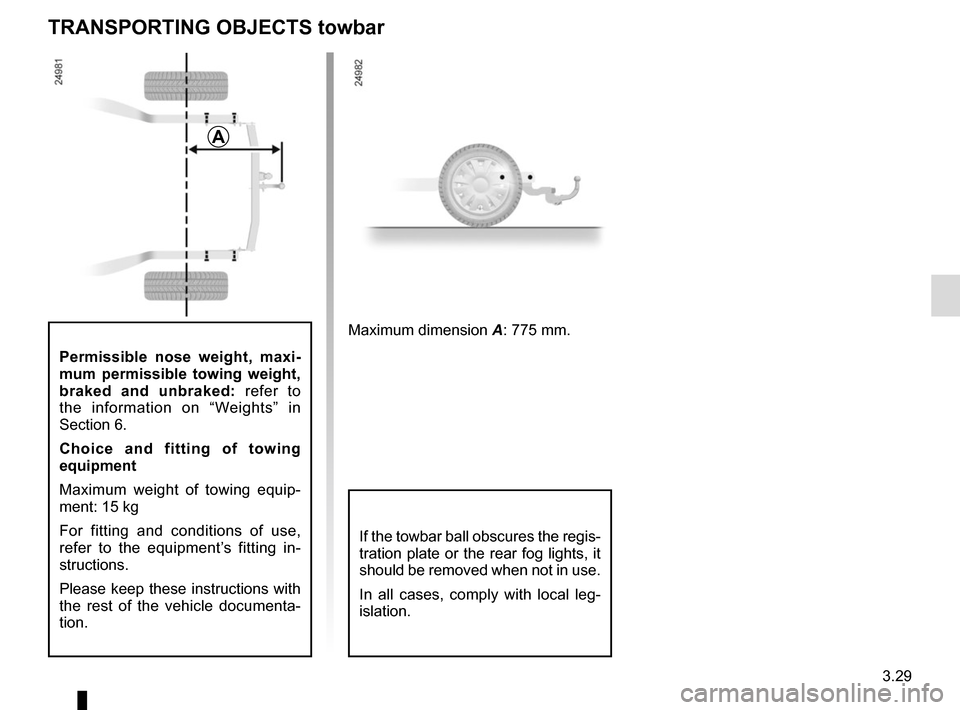
3.29
Permissible nose weight, maxi-
mum permissible towing weight,
braked and unbraked: refer to
the information on “Weights” in
Section 6.
Choice and fitting of towing
equipment
Maximum weight of towing equip-
ment: 15 kg
For fitting and conditions of use,
refer to the equipment’s fitting in-
structions.
Please keep these instructions with
the rest of the vehicle documenta-
tion.
TRANSPORTING OBJECTS towbar
A
Maximum dimension A: 775 mm.
If the towbar ball obscures the regis-
tration plate or the rear fog lights, it
should be removed when not in use.
In all cases, comply with local leg-
islation.
Page 169 of 244
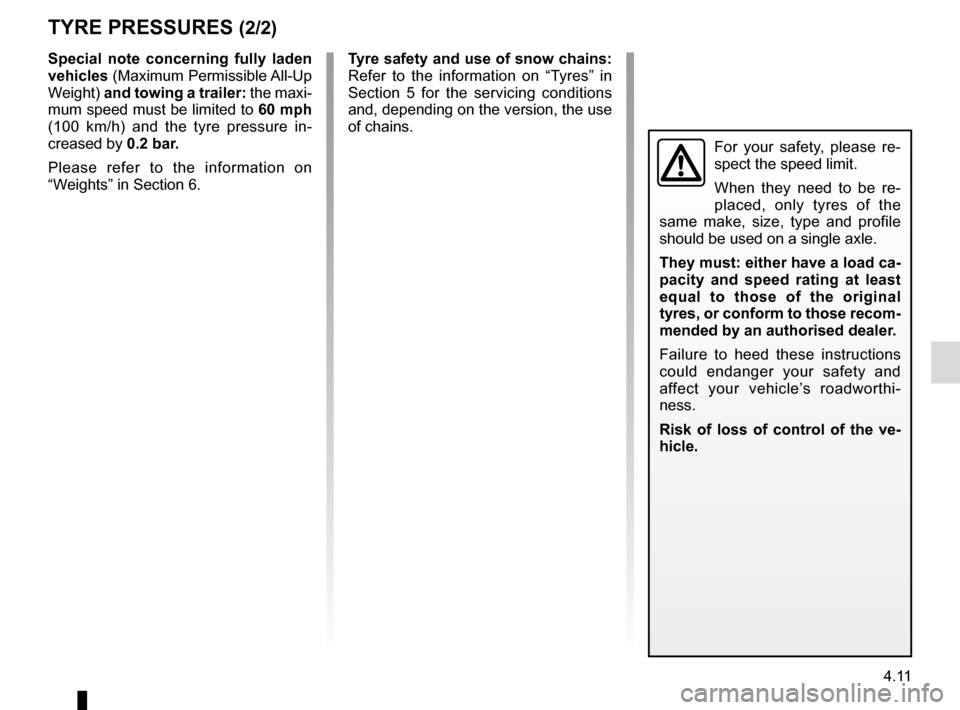
4.11
TYRE PRESSURES (2/2)
Special note concerning fully laden
vehicles (Maximum Permissible All-Up
Weight) and towing a trailer: the maxi-
mum speed must be limited to 60 mph
(100 km/h) and the tyre pressure in-
creased by 0.2 bar.
Please refer to the information on
“Weights” in Section 6. Tyre safety and use of snow chains:
Refer to the information on “Tyres” in
Section 5 for the servicing conditions
and, depending on the version, the use
of chains.
For your safety, please re-
spect the speed limit.
When they need to be re-
placed, only tyres of the
same make, size, type and profile
should be used on a single axle.
They must: either have a load ca-
pacity and speed rating at least
equal to those of the original
tyres, or conform to those recom-
mended by an authorised dealer.
Failure to heed these instructions
could endanger your safety and
affect your vehicle’s roadworthi-
ness.
Risk of loss of control of the ve-
hicle.
Page 203 of 244
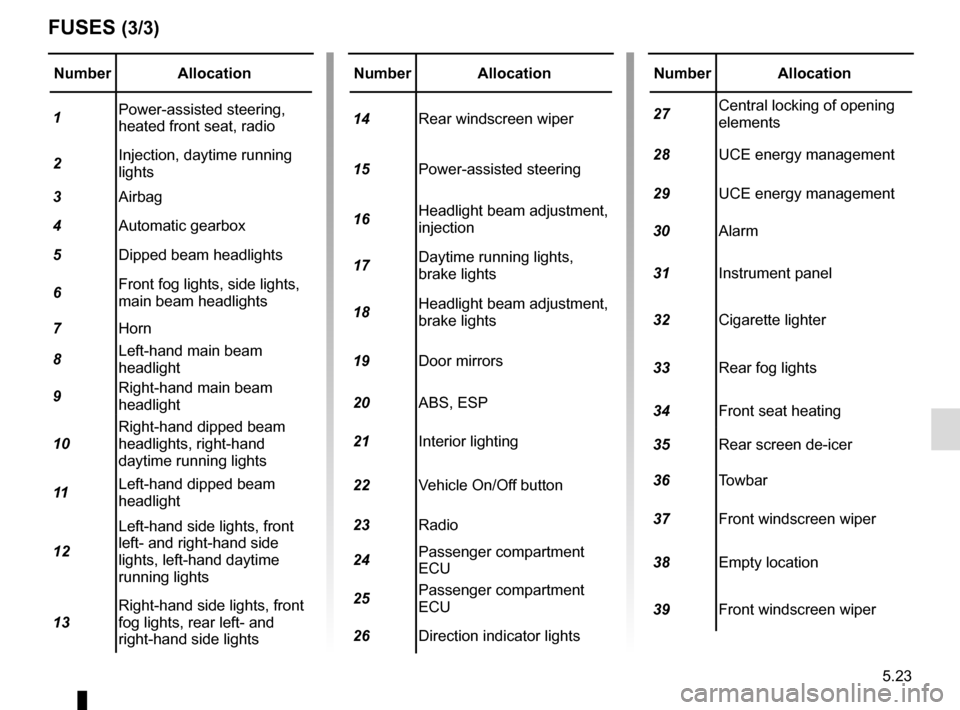
5.23
Number Allocation
1 Power-assisted steering,
heated front seat, radio
2 Injection, daytime running
lights
3 Airbag
4 Automatic gearbox
5 Dipped beam headlights
6 Front fog lights, side lights,
main beam headlights
7 Horn
8 Left-hand main beam
headlight
9 Right-hand main beam
headlight
10 Right-hand dipped beam
headlights, right-hand
daytime running lights
11 Left-hand dipped beam
headlight
12 Left-hand side lights, front
left- and right-hand side
lights, left-hand daytime
running lights
13 Right-hand side lights, front
fog lights, rear left- and
right-hand side lights
FUSES (3/3)
Number Allocation
14 Rear windscreen wiper
15 Power-assisted steering
16 Headlight beam adjustment,
injection
17 Daytime running lights,
brake lights
18 Headlight beam adjustment,
brake lights
19 Door mirrors
20 ABS, ESP
21 Interior lighting
22 Vehicle On/Off button
23 Radio
24 Passenger compartment
ECU
25 Passenger compartment
ECU
26 Direction indicator lightsNumber Allocation
27 Central locking of opening
elements
28 UCE energy management
29 UCE energy management
30 Alarm
31 Instrument panel
32 Cigarette lighter
33 Rear fog lights
34 Front seat heating
35 Rear screen de-icer
36 Towbar
37 Front windscreen wiper
38 Empty location
39 Front windscreen wiper
Page 211 of 244
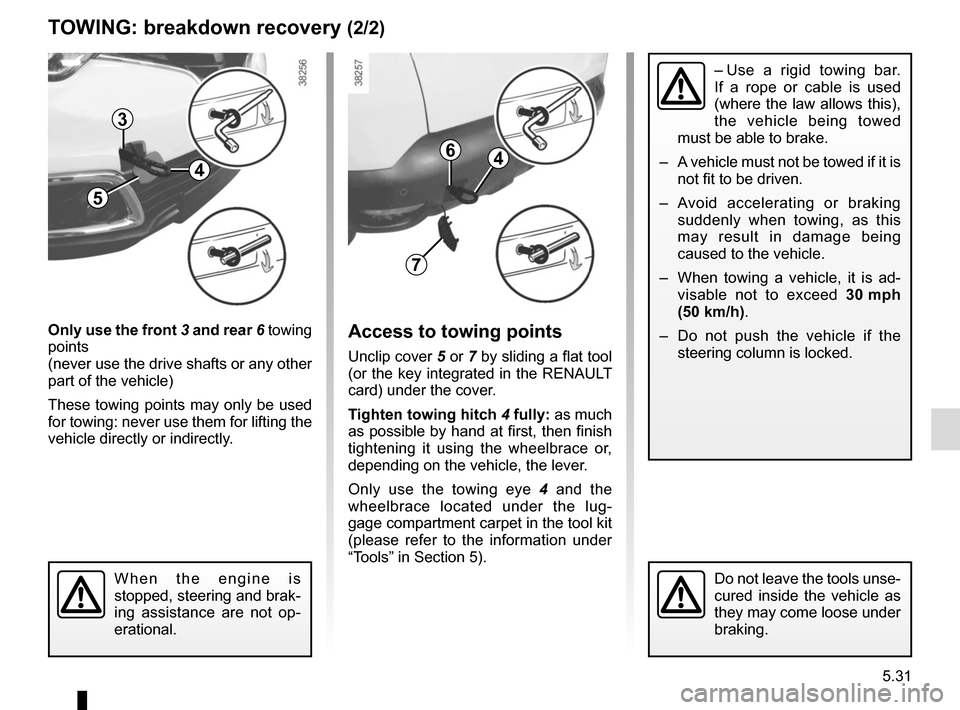
5.31
TOWING: breakdown recovery (2/2)
Only use the front 3 and rear 6 towing
points
(never use the drive shafts or any other
part of the vehicle)
These towing points may only be used
for towing: never use them for lifting the
vehicle directly or indirectly.Access to towing points
Unclip cover 5 or 7 by sliding a flat tool
(or the key integrated in the RENAULT
card) under the cover.
Tighten towing hitch 4 fully: as much
as possible by hand at first, then finish
tightening it using the wheelbrace or,
depending on the vehicle, the lever.
Only use the towing eye 4 and the
wheelbrace located under the lug-
gage compartment carpet in the tool kit
(please refer to the information under
“Tools” in Section 5).
When the engine is
stopped, steering and brak-
ing assistance are not op-
erational.Do not leave the tools unse-
cured inside the vehicle as
they may come loose under
braking.
6
7
4
– Use a rigid towing bar.
If a rope or cable is used
(where the law allows this),
the vehicle being towed
must be able to brake.
– A vehicle must not be towed if it is not fit to be driven.
– Avoid accelerating or braking suddenly when towing, as this
may result in damage being
caused to the vehicle.
– When towing a vehicle, it is ad- visable not to exceed 30 mph
(50 km/h).
– Do not push the vehicle if the steering column is locked.
5
4
3
Page 224 of 244
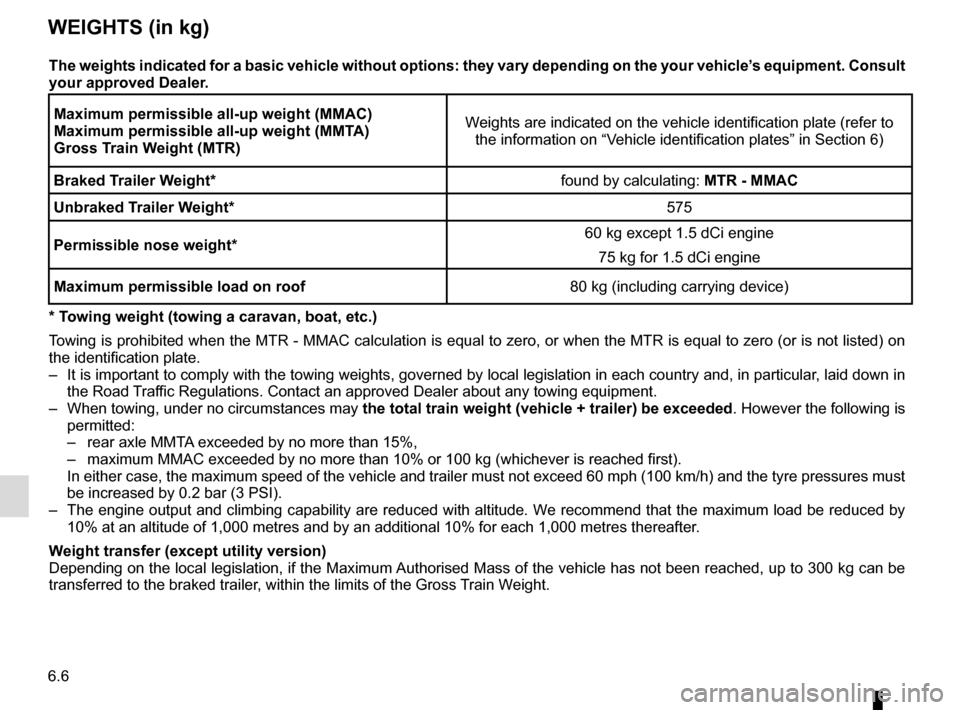
6.6
WEIGHTS (in kg)
The weights indicated for a basic vehicle without options: they vary dep\
ending on the your vehicle’s equipment. Consult
your approved Dealer.Maximum permissible all-up weight (MMAC)
Maximum permissible all-up weight (MMTA)
Gross Train Weight (MTR) Weights are indicated on the vehicle identification plate (refer to
the information on “Vehicle identification plates” in Section 6)
Braked Trailer Weight* found by calculating: MTR - MMAC
Unbraked Trailer Weight* 575
Permissible nose weight* 60 kg except 1.5 dCi engine
75 kg for 1.5 dCi engine
Maximum permissible load on roof 80 kg (including carrying device)
* Towing weight (towing a caravan, boat, etc.)
Towing is prohibited when the MTR - MMAC calculation is equal to zero, or\
when the MTR is equal to zero (or is not listed) on
the identification plate.
– It is important to comply with the towing weights, governed by local leg\
islation in each country and, in particular, laid down in the Road Traffic Regulations. Contact an approved Dealer about any towing equipment.
– When towing, under no circumstances may the total train weight (vehicle + trailer) be exceeded . However the following is
permitted:
– rear axle MMTA exceeded by no more than 15%,
– maximum MMAC exceeded by no more than 10% or 100 kg (whichever is reach\
ed first).
In either case, the maximum speed of the vehicle and trailer must not ex\
ceed 60 mph (100 km/h) and the tyre pressures must be increased by 0.2 bar (3 PSI).
– The engine output and climbing capability are reduced with altitude. We recommend that the maximum load be reduced by 10% at an altitude of 1,000 metres and by an additional 10% for each 1,0\
00 metres thereafter.
Weight transfer (except utility version)
Depending on the local legislation, if the Maximum Authorised Mass of the vehicle has not been reached, up to 300 kg can be\
transferred to the braked trailer, within the limits of the Gross Train Weight.
Page 240 of 244
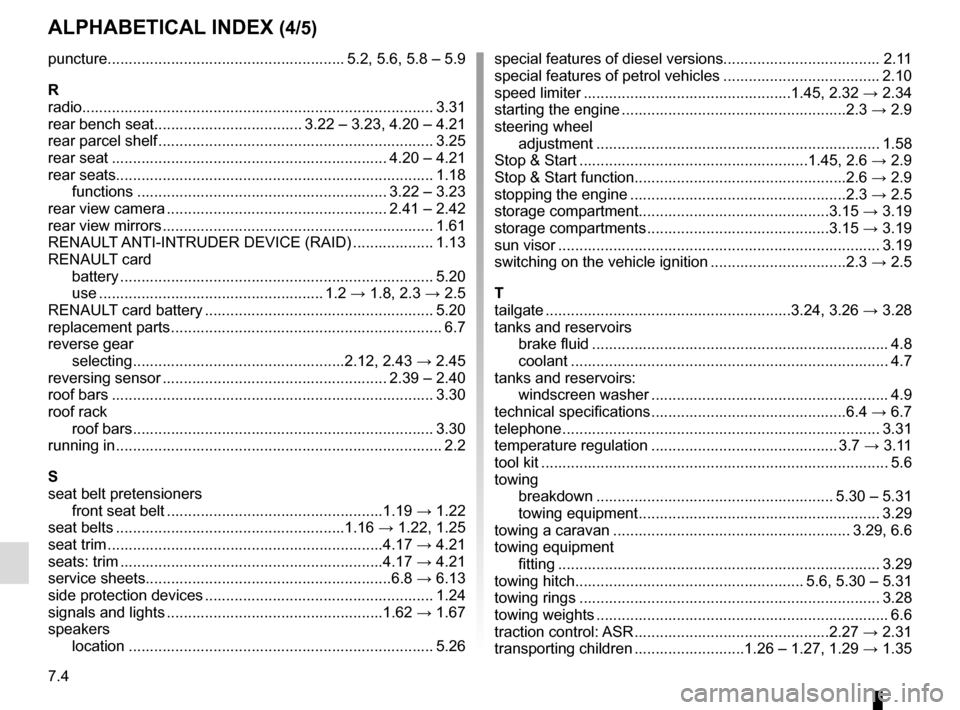
7.4
ALPHABETICAL INDEX (4/5)
puncture........................................................ 5.2, 5.6, 5.8 – 5.9
R
radio...................................................................\
................ 3.31
rear bench seat................................... 3.22 – 3.23, 4.20 – 4.21
rear parcel shelf ................................................................. 3.25
rear seat ................................................................. 4.20 – 4.21
rear seats..............................................................\
............. 1.18functions ........................................................... 3.22 – 3.23
rear view camera .................................................... 2.41 – 2.42
rear view mirrors ................................................................ 1.61
RENAULT ANTI-INTRUDER DEVICE (RAID) ................... 1.13
RENAULT card battery ................................................................\
.......... 5.20
use ..................................................... 1.2 → 1.8, 2.3 → 2.5
RENAULT card battery ...................................................... 5.20
replacement parts ................................................................ 6.7
reverse gear selecting ..................................................2.12, 2.43 → 2.45
reversing sensor ..................................................... 2.39 – 2.40
roof bars ........................................................................\
.... 3.30
roof rack roof bars ....................................................................... 3.30
running in ........................................................................\
..... 2.2
S
seat belt pretensioners front seat belt ...................................................1.19 → 1.22
seat belts ......................................................1.16 → 1.22, 1.25
seat trim .................................................................4.17 → 4.21
seats: trim ..............................................................4.17 → 4.21
service sheets..........................................................\
6.8 → 6.13
side protection devices ...................................................... 1.24
signals and lights ...................................................1.62 → 1.67
speakers location ...............................................................\
......... 5.26 special features of diesel versions.....................................\
2.11
special features of petrol vehicles ..................................... 2.10
speed limiter .................................................1.45, 2.32 → 2.34
starting the engine .....................................................2.3 → 2.9
steering wheel adjustment .............................................................\
...... 1.58
Stop & Start ......................................................1.45, 2.6 → 2.9
Stop & Start function..................................................2.6 → 2.9
stopping the engine ...................................................2.3 → 2.5
storage compartment.............................................3.15 → 3.19
storage compartments ...........................................3.15 → 3.19
sun visor ........................................................................\
.... 3.19
switching on the vehicle ignition ................................2.3 → 2.5
T
tailgate ..........................................................3.24,\
3.26 → 3.28
tanks and reservoirs brake fluid ...................................................................... 4.8
coolant ................................................................\
........... 4.7
tanks and reservoirs: windscreen washer ........................................................ 4.9
technical specifications ..............................................6.4 → 6.7
telephone ..............................................................\
............. 3.31
temperature regulation ............................................ 3.7 → 3.11
tool kit ........................................................................\
.......... 5.6
towing breakdown ........................................................ 5.30 – 5.31
towing equipment ......................................................... 3.29
towing a caravan ........................................................ 3.29, 6.6
towing equipment fitting ................................................................\
............ 3.29
towing hitch...................................................... 5.6, 5.30 – 5.31
towing rings ....................................................................... 3.28
towing weights ..................................................................... 6.6
traction control: ASR ..............................................2.27 → 2.31
transporting children ..........................1.26 – 1.27, 1.29 → 1.35